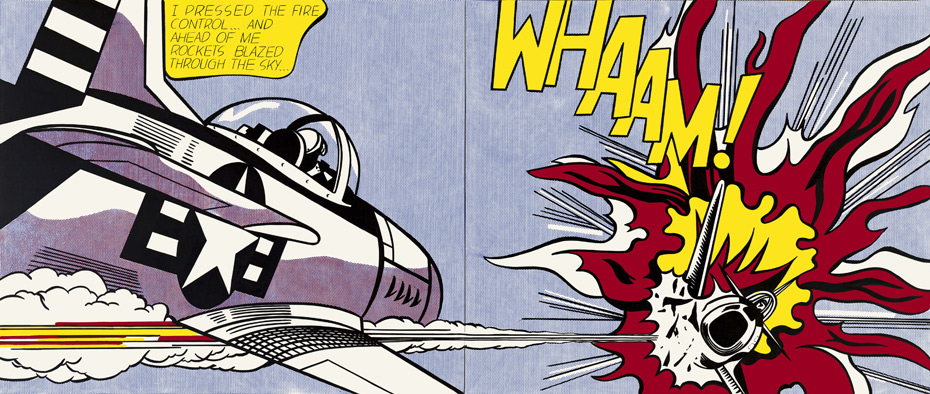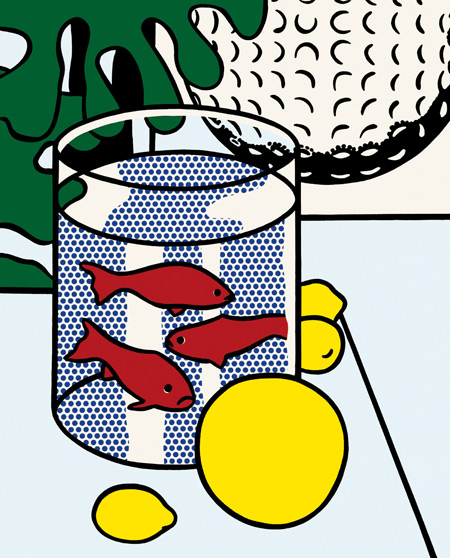
William Kherbek looks over the new retrospective of Pop Art’s poster-child at the Tate Modern
So maybe it was the bagel I had for breakfast, but for some reason I kept thinking about René Descartes at the Tate Modern’s retrospective of the American Pop Art hierophant Roy Lichtenstein. I know, 17th century French philosophy kind of cuts against the mission statement of Pop Art, but the deeper I got, the more sense it made.
Take the first room for example: there’s no getting past the fact that the first room of the exhibition is one of the most didactically hung rooms in the history of painting. It’s just the Tate’s little way of making sure we know the difference between a brushstroke and a Ben-Day Dot, the little proto-pixels that made up images in newsprint and most comics in Lichtenstein’s heyday. The works, Brushstrokes and Brushstroke with Splatter make that distinction about as clear as humanly/curatorially possible. Lichtenstein devotees will, of course, know where this is going: the works emphasise the differences between modes of representation in fine art and in mass media. But the thing is, when you look at the Ben-Day dots, there’s a kind of alchemy. As everybody but Giotto knows, you don’t get perfect circles in nature, and Lichtenstein’s dots have an imperfection that can only be described as exceedingly painterly. Lichtenstein makes the point even more clear with his “perfect” and “imperfect paintings hung together in a later room in the show. The works consist of canvases covered in geometric forms which cover sections of the picture plane and sometimes the wall beyond it. They’re perfect if they stay in the frame, imperfect if they don’t. And so Descartes is no longer just a bit of undigested cheddar. Lichtenstein’s “imperfections” hint at a deeper imperfection in the visual sense itself: we don’t ever “see” triangles with our eyes, we see representations of triangles, some wonkier than others, and somehow we recognise them as triangles. Nature doesn’t know straight lines, but geometry does, and Lichtenstein clearly knew that well. The power to reveal is the necessity to deceive. But it’s never just “magic eye” tricks in Lichtenstein, throughout a masterful survey of work, you feel the stylistic and conceptual seriousness that his deadpan hilarity mandates.

Once you get past the first room, fortunately, a lot more is left to the viewer to decide, and that’s fitting, because if there was one thing Lichtenstein liked, it was ambiguity. Take the famous comic strip images. All the narratives are broken up, fragmented and as artificial as the dots that compose them, but they’re also extremely pure, painted images based upon drawn images. Faking it so real they are beyond fake, as someone once sang. And beyond the real too, as that person didn’t. It’s good to see the source materials as well, a few sections from the All American Men of War comics are on show to compare the source image to Lichtenstein’s, notably the famous Whaam! of a heroic All American Man of War annihilating his enemy. The colour scheme is different, the sky, for one thing, changes from red to blue as the work sublimes from comic into painting. Some of the text drops away. The “whaam” of the missile into Commie jet isn’t the triumphal apotheosis it is in the comic; it’s a drier, more ambivalent kind of apotheosis.
Word count looms, but just to say it’s a terrific ride from start to finish. The only time it loses its momentum is the “Art About Art” room in which Lichtenstein’s art falls on the wrong side of artistic satire, rarely bringing anything new to the iconic works he satirises. Only the Mondrian-baiting Non-Objective I manages to bring sustained laughter as well as chin-stroking. But that’s a mirco-complaint, especially when there are works as complicated, screwed up, and fun as Lichtenstein’s late 80s rendering of Laocoön, and as oddly serene and apposite works based on Chinese scroll paintings. Whaam! indeed.
Roy Lichtenstein: A Retrospective run until 27 May at Tate Modern, Bankside, London SE1 9TG




